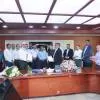As India undertakes transformative infrastructure projects, the need for a skilled workforce is more critical than ever. While the construction industry is a major economic contributor, it faces challenges in workforce development, especially with a significant portion operating informally and lacking formal training. CONSTRUCTION WORLD and Equipment India organised a panel discussion featuring industry leaders discussing the urgent need for skilling in the construction equipment sector. Here are some highlights.Growing demand for skilled labourThe construction and engineering sectors in India are experiencing a significant boom, driven by government initiatives like the Pradhan Mantri Awas Yojana (PMAY) and private investments aimed at modernising the country’s infrastructure. This boom has led to an exponential increase in the demand for skilled labour. The industry is not just building bridges, roads and skyscrapers – it is laying the foundation for the nation’s future economic growth.“India’s ambitious growth trajectory is embarking on major mega projects that were once deemed impossible,” says SP Rajan, Vice President and Head of Plant and Machinery, L&T Construction. “These endeavours are not just engineering feats; they are proof of our potential – our potential of a skilled workforce.”Vijay Kumar, CEO, Infrastructure Equipment Skill Council (IESC), is acutely aware of the need to grow this skilled workforce. According to him, about 1,00,000 pieces of construction equipment are sold annually in India. Each piece of machinery requires trained operators and technicians to function efficiently, yet the industry faces a significant shortage of skilled workers. “Even if we account for two operators per piece of equipment, we need 2,00,000 operators every year,” he reasons. “The challenge is even greater when you consider the technicians needed for maintenance.”However, much of the current workforce learns their trade informally, often as helpers on job sites. While this method has its merits, it falls short in providing comprehensive training, especially in critical areas such as safety, environmental awareness and basic troubleshooting. The absence of formal training and certification leaves significant gaps, leading to inefficiencies, higher operational costs and, most worryingly, compromised safety on construction sites.“Our journey to becoming a global construction powerhouse is undoubtedly linked to the skill of our workforce,” asserts Rajan. “But this workforce is still part of an unorganised sector that forms the backbone of our industry.”Building the futureThe need for a skilled workforce has led to a concerted effort by various stakeholders to address the skill gap through targeted training programmes. IESC, at the forefront of this movement, offers structured training programmes that go beyond basic machine operation to include soft skills like computer literacy, financial literacy and effective communication. “By incorporating soft skills into our training, we ensure that operators are proficient in their tasks, adaptable to the rapidly changing technological landscape and capable of growing into more complex roles,” says Kumar.IESC’s training programmes are designed to cover a broad spectrum of skills. For instance, operators are trained to conduct pre-operational safety checks, perform basic troubleshooting and understand the environmental impact of their work. This approach ensures that workers are better equipped to meet the demands of modern construction projects, where timelines are tight and the margin for error is slim.Commitment to skillingRecognising the critical need for skilled labour, corporate India is playing a vital role in this skilling revolution. Leading companies like Schwing Stetter India and Terex India understand that a well-trained workforce is not just a necessity for operational efficiency but also a key competitive advantage. They have made skill development a cornerstone of their corporate strategies.S Baskar Babu, Senior Vice President - Training and Corporate Communications, Schwing Stetter India, explains that the company has established a world-class training institute at its factory in Tamil Nadu. “We don’t just stop at selling equipment; we ensure that our customers, vendors and employees are thoroughly trained to operate and maintain these machines.” Schwing Stetter’s training programmes incorporate both theoretical and practical components. “Our training institute is equipped with state-of-the-art welding simulators and practical labs,” says Babu. “We train not only our employees but also operators and technicians of our clients.”This commitment to skilling extends to external partners as well. Schwing Stetter collaborates with various state government skill development corporations to train unemployed youth in construction equipment operation. The company’s efforts have led to the training and certification of thousands of operators, many of whom have gone on to secure employment with leading construction firms across India.For his part, Amol Sinha, Director, Product and Training, Terex India, says his company has developed a robust training programme that covers a wide range of skills, from basic machinery operation to advanced topics like electric mobility and power electronics.“We provide tailored training programmes for different roles within the company, ensuring that everyone, from engineers to assembly line workers, is proficient in the latest technologies,” says Sinha, which ensures that Terex remains competitive in a fast-changing industry.“Our corporate partners like Schwing Stetter and Terex are not just contributing to the economy but also playing a pivotal role in building a skilled India,” notes Rajan. “Their commitment to skilling ensures that our workforce is well prepared to tackle future challenges.”Role of technology in skillingAs the construction industry becomes increasingly technology-driven, advanced technologies like augmented reality (AR), virtual reality (VR) and connected machines are making operators more efficient and better prepared to handle the complexities of modern construction projects.Kumar highlights the importance of integrating these technologies into training programmes. “The machinery we use today is vastly different from what it was even a decade ago,” he points out. “Telematics, IoT and predictive maintenance systems are now standard features. Our training programmes need to evolve to ensure that operators can fully utilise the capabilities of modern machinery.”IESC is already incorporating AR and VR into its training modules. “AR and VR allow us to simulate real-world conditions, providing operators with the experience they need without the associated risks,” adds Kumar. “This is particularly valuable in a sector where practical experience is crucial.”Babu agrees, noting that these technologies are becoming integral to training programmes at his company. “AR and VR tools not only enhance the learning experience but also ensure that our operators are better prepared to handle real-world scenarios.”Andrei Geikalo, Founder and CEO, MyCrane, emphasising the importance of complementing digital tools with hands-on training says, “We ensure that our suppliers have access to training materials and industry guidelines. This combination of digital resources and hands-on experience ensures that crane operators meet the highest standards of proficiency and safety.”Overcoming challengesDespite these advancements, significant challenges remain in the skilling landscape. Mobilising candidates for training programmes is one of the most pressing issues. The construction industry has long been seen as less desirable compared to white-collar professions, a perception that deters potential candidates. Moreover, the geographical spread of India’s infrastructure projects often requires workers to relocate, a prospect that many find unappealing.To address this issue, Schwing Stetter has partnered with local businesses and government agencies to provide on-the-job training. “By working with local players, we can offer practical, hands-on training that reduces costs and makes it easier to mobilise candidates,” says Babu.The cost of training, particularly for advanced equipment, is another significant barrier. Training involves machine downtime, fuel consumption and wear and tear on equipment. “Training is expensive,” says Sinha. “But it’s an investment that pays off in the long run.” To mitigate these costs, Terexcombines theoretical instruction with practical experience and digital tools like AR and VR.Meanwhile, Ratan Lal Kashyap, President – SCM, Dineshchandra Agrawal Infracon, emphasises the importance of retaining skilled workers. “As the sector expands, retention of skilled workers is a major challenge,” he notes. To combat this, companies are implementing robust systems for employee engagement. “We need to ensure that our employees see a clear path for advancement within the company,” he adds. “This is key to retaining talent.”“Addressing these challenges requires innovation and collaboration,” says Rajan.Future of skilling in IndiaLooking to the future, the construction industry will increasingly rely on a skilled workforce capable of operating within a highly technological environment. There is growing consensus among industry leaders that formal certification and licensing of operators, similar to what exists in the automotive industry, are essential for maintaining high standards of safety and efficiency. HS Mohan, former CEO, IESC, advocates a licensing system for equipment operators. This, apart from improving safety, is also about professionalising the workforce. “If we can align our programmes with global standards, we can open up a wealth of opportunities for our workforce.” This will benefit workers and enhance India’s reputation as a hub for skilled labour.The road aheadAs the country scales new heights in infrastructure, a ‘Skilled India’ will meet the needs of the sector and also lay the foundation for an economy that can compete on the global stage. With the right strategies, India is well on its way to becoming a global leader in infrastructure development, powered by a workforce that is as skilled as it is ambitious. - KARTHIK MUTHUVEERAN


















